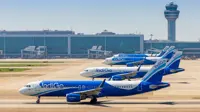Indian Railways has emerged as the preferred mode of transportation for automobile manufacturers, due to its low cost of transportation, faster service, reliability and safer deliveries.
In 2017-18, around 29 million vehicles were produced in country registering a growth of 14.78 per cent year on year, which is poised to grow even faster in India, given the rising prosperity across the country.
And these vehicles need to be transported to the far flung areas wherever the buyers are located.
To capture this freight segment, Indian Railways has taken a number of initiatives.
The railway board's member traffic, Mohd Jamhsed said, “2017-18 has witnessed a paradigm shift in the marketing efforts of Indian Railways to attract automobile traffic and enhance our freight basket. In the later half of 2017-18, we decided to liberalise Automobile Freight Train Operator (AFTO) policy to encourage more private investment in special wagons, procurement of our own high-capacity BCACBM [Bi Level Auto Car Carrier] railway wagons and NMG wagons.
"In April, 2018, we have taken two game-changing decisions to allow handling of automobile from all container terminals and to allow loading automobile and auto spares in privately-owned wagons in different directions for optimal utilisation of stock.”
According to Indian Railways, it is working closely with the automobile industry to develop policies, which are mutually beneficial to the industry as well as the railways.
The results of these initiatives led to the enhancement of automobile movement by rail in 2017-18 resulting in 16 per cent higher loading 18 per cent higher earnings compared to 2016-17.
In April, 2018 Indian Railways liberalised its automobile freight train operator (AFTO) Policy. Earlier, the transportation of automobile and auto spare by AFTOs was permitted only in one direction.
With the coming up of auto-hubs across the country, this restriction has now been lifted. AFTOs will be able to utilise their rakes for loading in different directions and will be able to optimise the utilisation of their rakes.
Earlier, the loading of automobile was permitted only from auto hubs, private freight terminals’ (PFT) and railway good sheds with automobile handling facilities, which had severely restricted automobile loading on account of limited availability and capacity of such terminals.
Indian Railways has now decided that the loading and unloading of automobile will be permitted from all inland container depots (ICDs),
Container terminals managed by container train operators. This shall result in availability of additional 86 locations in addition to the earlier auto hubs, PFTs and railway good sheds with automobile handling facilities.
With these measures, the railways expects to further enhance its share of auto movements.






















